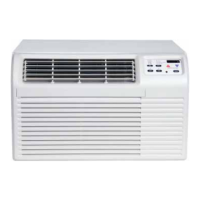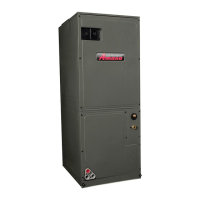17
1. Press FAULT RECALL button for 2 to 5 seconds
*
,
so that 7 segment display shows “- -”.
2. Release FAULT RECALL button in this period, 7
segment display shows the most recent fault.
3. Each time FAULT RECALL button is pressed after
that
**
, 7 segment display outputs next occurred fault.
4. After displaying the series of recent faults, 7 segment
displays blink “- -” and goes back to Standby Mode.
To clear the error code history:
1. Press FAULT RECALL button for 10 to 15 seconds
***
,
so that 7 segment displays blink “- -”.
2. Release FAULT RECALL button in this period, 7
segment displays show “88” and faults are cleared.
* If FAULT RECALL button is not pressed long enough (for 2 to 5 sec-
onds), control goes back to Standby Mode.
If the FAULT RECALL button is pressed for 5 to 10 seconds, control
goes back to Standby Mode.
** Consecutively repeated faults are displayed a maximum of three times.
*** If FAULT RECALL button is pressed for longer than 15 seconds, control
goes back to Standby Mode.
For a detailed prodedure of the thermostat
commissioning process, please visit the Amana Smart
Thermostat website at https://www.amana-hac.com/
17.1 Overview
A fully communicating Amana system is a system that
includes a compatible air handler and air conditioner or
heat pump with a communicating thermostat.
A fully communicating Amana heating/air conditioning
system diers from a non-communicating/traditional sys-
tem in the manner in which the indoor unit, outdoor unit
and thermostat interact with one another. In a traditional
system, the thermostat sends commands to the indoor and
outdoor units via analog 24 VAC signals. It is a one-way
communication path. The indoor and outdoor units typically
do not return information to the thermostat.
For a fully communicating Amana system, the indoor unit,
outdoor unit, and thermostat “communicate” digitally with
one another. It is now a two-way communications path.
The thermostat still sends commands to the indoor and
outdoor units and may also request and receive information
from both the indoor and outdoor units. This information
may be displayed on the communicating thermostat. The
indoor and outdoor units also interact with one another. The
outdoor unit may send commands to or request information
from the indoor unit. This two-way digital communications
between the thermostat and subsystems (indoor/outdoor
unit) is the key to unlocking the benets and features of
the fully comunicating Amana system.
Two-way digital communications is accomplished using
only two wires. The thermostat and air handler controls
are powered with 24 VAC. A maximum of 4 wires between
the air handler and thermostat is required to operate
the system. An inverter equipped outdoor unit does not
require 24 VAC. Only the 2 digital communication wires
are required between the air handler and inverter unit
(pins 1 and 2 on the thermostat connector.)
17.2 Airow Consideration
Airow demands are managed dierently in a fully com-
municating system than in a non-communicating wired
system. The system operating mode (as determined
by the thermostat) determines which unit calculates the
system airow demand. If the indoor unit is responsible
for determining the airow demand, it calculates the de-
mand and sends it to the ECM motor. If the outdoor unit
or thermostat is responsible for determining the demand,
it calculates the demand and transmits the demand along
with a fan request to the indoor unit. The indoor unit then
sends the demand to the ECM motor. Table 11 lists the
various fully communicating Amana systems, the oper-
ating mode, and airow demand source.
For example, assume the system is a heat pump matched
with an air handler. With a call for low stage cooling, the
heat pump will calculate the system’s low stage cooling
airow demand. The heat pump will then send a fan re-
quest along with the low stage cooling airow demand to
the air handler. Once received, the air handler will send
the low stage cooling airow demand to the ECM motor.
The ECM motor then delivers the low stage cooling airow.
See the applicable fully communicating Amana system
air conditioner or heat pump installation manual for the
airow delivered during cooling or heat pump heating.
In continuous fan mode, the communicating thermostat
provides the airflow demand. The communicating
thermostat provides 4 continuous fan speeds (25%, 50%,
75% and 100% of maximum airow). During continuous
fan operation, the thermostat sends a fan request along
with the continuous fan demand to the air handler. The air
handler, in turn, sends the demand to the ECM motor. The
ECM motor delivers the requested continuous fan airow.
17.3 Thermostat Wiring
Refer to section Electrical Connections for
208/230 volt line connections to the air handler.
It is recommended that no more
than two wires be connected in a single terminal. If two
wires are used in a terminal, it is recommended the
same type of wire be used (i.e. Both stranded or solid
for secure connection). Failure to do so may result in
intermittent operation.
Typical 18 AWG thermostat wire may be used to wire the
system components. Two hundred fty (250) feet is the
maximum of wire between indoor unit and outdoor unit,
and one hundred twenty ve (125) feet between indoor
unit and thermostat.

